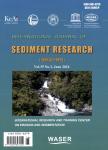Geographic distribution of arsenic contamination in the Himalayan Rivers flowing through Pakistan: Implications for its natural source and effects of anthropogenic activities
作者机构:Environmental Geochemistry Laboratory Department of Environmental Sciences Faculty of Biological Sciences Quaid-i-Azam University Department of Environmental Sciences University of Baltistan Skardu Graduate School of Sciences and Engineering Kagoshima University Department of Earth and Planetary Environmental Science (UG) Graduate School of Science The University of Tokyo Department of Earth and Planetary Physics (UG) Graduate School of Science The University of Tokyo Department of Earth and Planetary Science (GR) Graduate School of Science The University of Tokyo
出 版 物:《International Journal of Sediment Research》 (国际泥沙研究(英文版))
年 卷 期:2023年第38卷第4期
页 面:543-555页
核心收录:
学科分类:0830[工学-环境科学与工程(可授工学、理学、农学学位)] 08[工学] 0815[工学-水利工程]
主 题:Arsenic Indus basin Geochemical baseline Source Contamination assessment
摘 要:Arsenic(As) in natural hydrological systems is known as a worldwide major environmental concern. A geochemical and sedimentological study was done to ascertain the origin and geographical distribution of As in surface water and fluvial sediment collected from the floodplains/basins of the River Indus and its four major tributaries that drain through the northern Pakistan. The hydrogeochemical compositions of all five rivers were similar with calcium(Ca2+) and bicarbonate(HCO3-) being the dominating ions. The concentration of As ranged from 0.62-24.05 μg/L(average 3.7 ± 3.5 μg/L, n = 61) in river water, 2.3-23.4 mg/kg(average 5.7 ± 3.9 mg/kg) in suspended sediment, and 2.0-13 mg/kg(average4.13 ± 2.3 mg/kg) in fluvial sediment. Various approaches were used, including mineralogical, sequential extraction, geochemical, and statistical analyses to investigate the distribution, behavior, and potential sources of As in the sediment. The effect of geological factors on the distribution of As was also studied.No noticeable changes in the relative abundance of minerals were observed in the sediment at different locations along the river. Both mineralogical and statistical analyses showed that silicate minerals like muscovite, biotite, and chloride are the main As reservoir while oxides minerals like hematite and magnetite, which are minor components in the sediment are second largest As carrier. A geochemical baseline, using the normalization and cumulative frequency distribution curves was constructed for As.The estimated mean human contribution of As was 3.4% in the Indus River, 1.9% in the Jhelum River, 13.7%in the Chenab River, 17.5% in the Ravi River and 5.4% in the Sutlej River, indicating relatively higher effects of anthropogenic activity along the Chenab River and Ravi River. The almost negligible effects of anthropogenic activities were additionally confirmed through the pollution assessment parameters estimated from the geo-enrichment, contamination factors, and accumulation index analyses. The current data suggest that As transported by the Indus River and its major tributaries is accumulated in the sediment and is potentially incorporated in the sedimentary aquifers situated along the Indus Basin and surrounding areas. Based on the current study, it is concluded that the source of As is dominantly geogenic whereas the role of anthropogenic activities is considered negligible except along the Ravi River which showed relatively a higher percentage(17.5%) of human or industrial contribution.



